Last updated on
Looking for the right type of kitchen sink for your next renovation project? Even if you’re just swapping out an old sink, you will find a better option on our list of 21 kinds of kitchen sinks.
Most kitchen guides offer 10 popular types of kitchen sinks. And we offer them two plus the additional kids of sinks to give you that many more options to consider. We realize that you need more options than specific brands and products at this stage of planning your renovation.
Do you need a double or single bowl sink? Stainless steel, cast iron, or other material? Do you have a hard water issue? How many faucets, sprayers, and soap dispensers will you use? How about drainage and garbage disposal? What countertops do you have, and are you planning to change them too? What effect it will have on your design?
These are all great questions to ask, and different types of kitchen sinks offer different solutions. We have guides for the best kitchen sinks but first, let’s find out which type works for you.
To illustrate what each sink looks like, we have included specific examples. If they come from an online shop, our site gets a commission from the shopping links (we are upfront about it.)
Let’s choose the sink that will work in your kitchen.
What's Inside
Single Bowl Sink
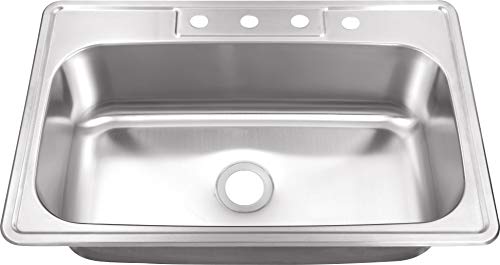
A single bowl sink is the best option for families or individuals with limited counter space. A single bowl sink allows you to wash large pots easily and without the worry of the pot hitting your countertop. Single sinks are not good for multitasking, so it is a preferred choice after going through a thorough review of all choices.
Double Bowl Sink
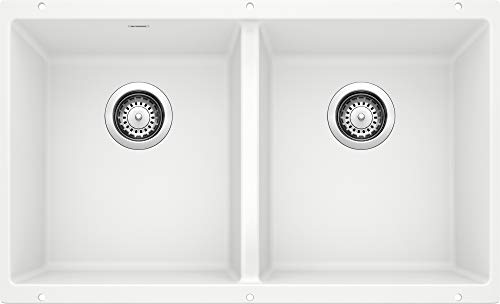
The most popular kitchen sink arrangement, two basins on each side, allows for washing and rinsing or drying. This type of sink has all sink operations covered and can be useful in households without a dishwasher. Some homeowners don’t like the utilitarian appearance, while others prefer this style. In present times some people want a single basin instead of two.
Low Divider Double Basin Sink
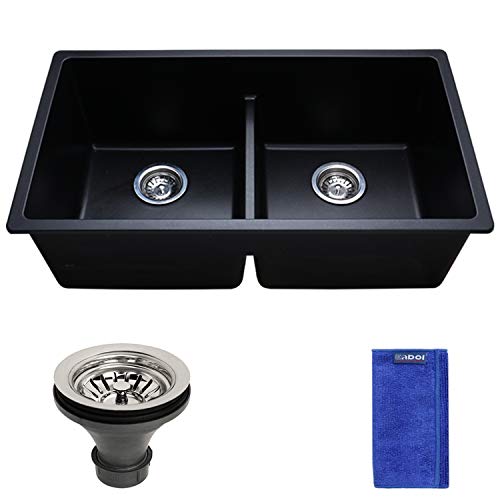
A low divider sink separates the two bowls by a small partition in the middle of the sink and allows for food to be washed in one basin while usable space in the other basin is available. Low divider sinks can function as double basins but have less space than ordinary double sinks. The features of such sinks make them popular for food preparation since it is easier to rinse dishes with water within easy reach, instead of having to pass items from one side to another.
Top Mount Sink

Also known as the drop-in or overmount sink, the top mount kitchen sink is a sink that goes into the counter and makes a rim around the sink. While this is typically a versatile option because it’s easy to install and provides extra support for almost any material, one factor to consider with this type of kitchen sink is how filth and food particles can get caught on the rim and make cleanup more difficult.
Undermount Sink
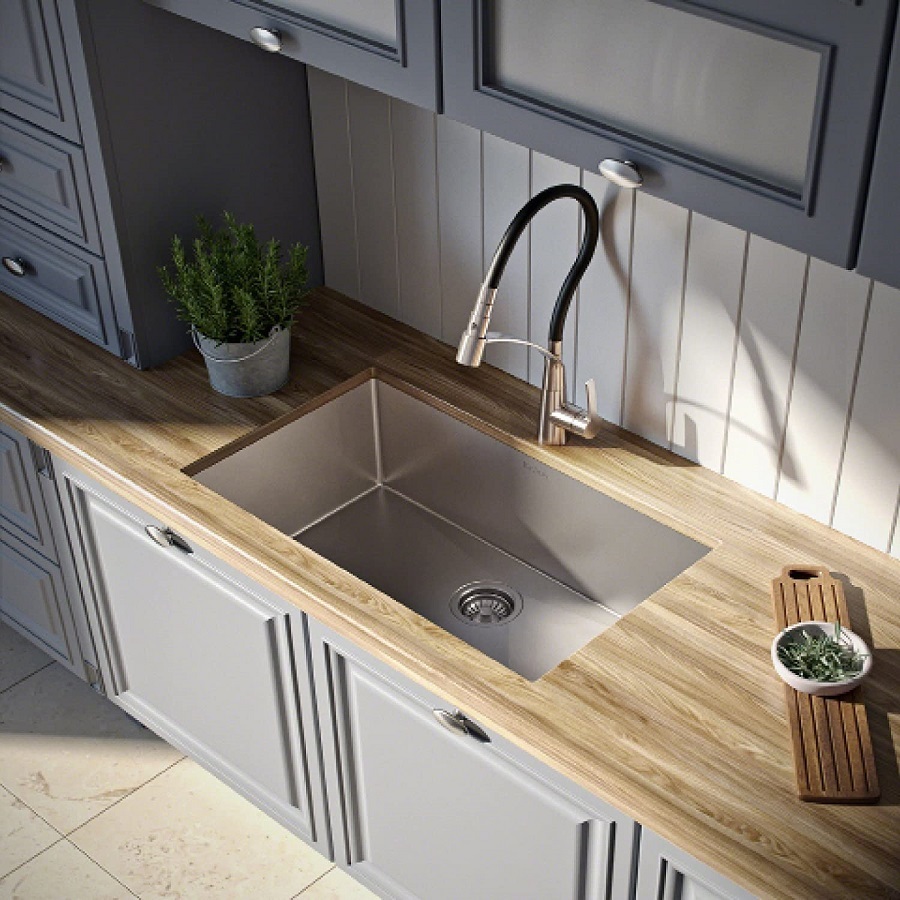
An undermount sink is installed directly under the countertop (see undermount vs. overmount kitchen sinks). It provides a seamless appearance from the kitchen top to the sink and makes clean-up easier because debris will be pushed away into the drain without catching on the rim or lip. This type of sink installs below countertops without any framing showing in between, making it seem as if it just blends right in with the counters like a smooth transition where water can go down easily. Other features include neat storage underneath. The sink can be a single or double basin but it cannot include a drainboard.
Flush Mount Sink
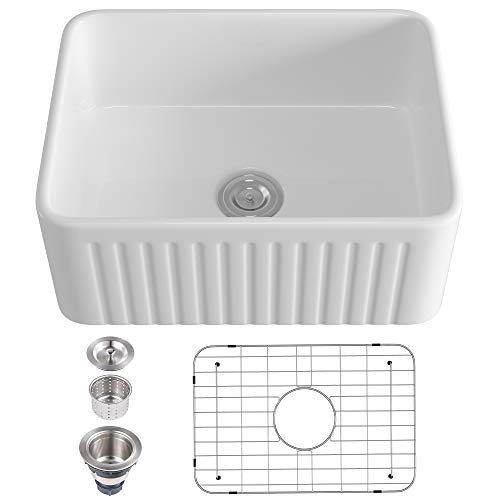
Flush mount kitchen sinks are sinks where the sink material is the same level as the countertop material. You can see these types of sinks as having an “easy sweep” feature because if any crumbs fall into it, they will get swept into the sink instead of staying on top. However, flush mounts don’t have a raised edge around them like undermount, so there will always be this gap (no matter how small) between the two surfaces to create a continuous surface.
Self-Rimming Sink
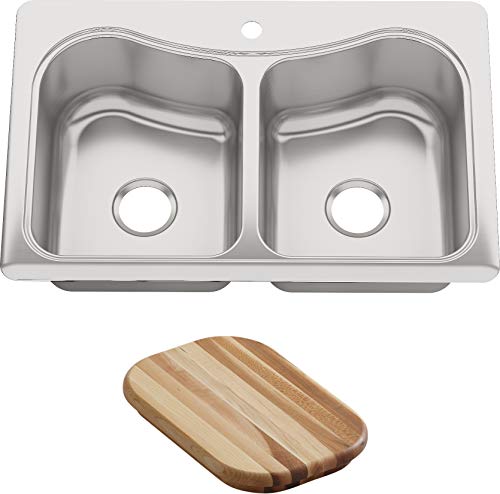
Find the correct size for your chosen model and stitch it in place with epoxy, caulking, or silicone to make it waterproof. The rim supports the sink and creates an unusual style in your kitchen (creative idea). You are not limited to choosing what type you want because they are simple to install on any surface.
Stainless Steel Sink

A stainless steel sink is a type of sink made of stainless steel metal (typically grade 304). A thickness designation indicates the gauge or thickness, thick options being heavier and cheaper but quiet, thin options being lighter and more expensive though louder than other types of sinks. Stainless steel sinks often need repairs from time to time due to denting issues but resist heat and stains better than some surfaces.
Farmhouse Apron Sink

A farmhouse sink is a plumbing fixture used in kitchens, most commonly found in traditional or rustic-type settings such as a farmhouse. A single-bowl style of this sink will most often be used underneath a countertop, while the double bowl type can be designed as an under-mount or island sink because it extends out from the counter. Casting iron is typically used for construction; nesting designs are popular today with their low profile that matches well with smaller spaces.
Bar Prep Sink

These are typically small and shallow sinks, which is great for those who like to entertain people or have a large family. If you have a home bar or terrace bar, consider getting a kitchen sink as well, but when buying the two of them together, the size must match up.
Corner Sink
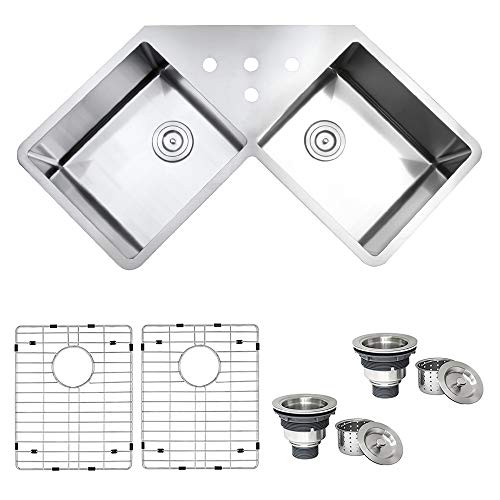
Corner sinks are not typical sinks. These are double basin sinks with two separate faucets, one on either side of the corner sink. This is because how it was designed to fit in the corner of your counter with such little space remaining between its catty-cornered sides and the opposing wall. Corner Sinks now come in almost any color, from shiny chrome to light grays, antique brass, and many more colors, so you’re sure to find one that will match your decor.
Granite Composite Sink
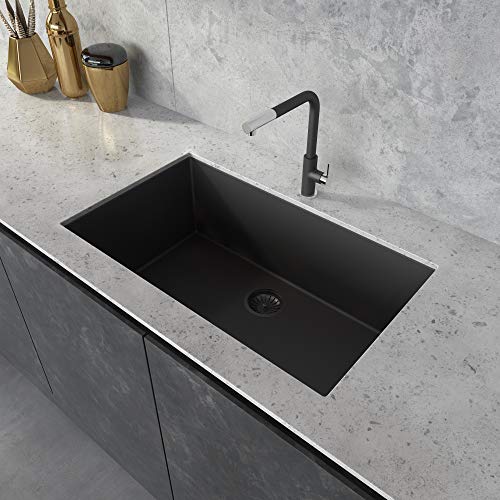
Granite composite kitchen sinks are a durable and modern option for your kitchen. They fill pulverized granite together with a resin filler. There are inherent sound-absorbing qualities due to the density of the sink material. If you’re considering one of these sinks, you’ll want to ensure that your countertops can hold the extra weight because they may be heavier than stainless steel ones.
Cast Iron Sink
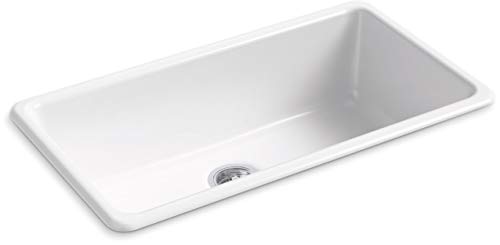
Cast iron sinks are sprayed with a coating that tends to give them a glossy white finish. Cleaning up these sinks is not recommended due to the abrasive cleaners that will wear down the porcelain coating and possibly damage other dishes. It would be best if you were careful when washing dishes, considering your sink’s hardness may cause chipping on dishware.
Kitchen Island Sink
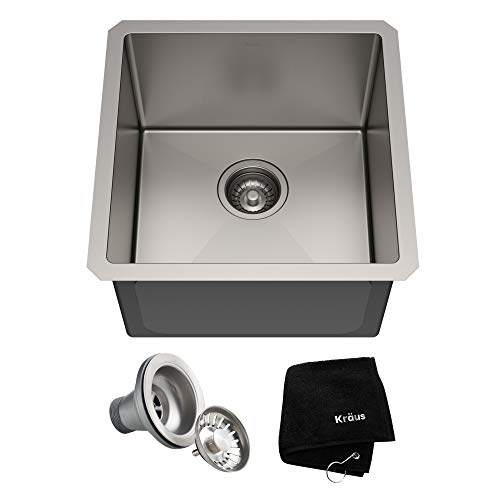
Kitchen islands are becoming more popular, and with them, the demand for kitchen island sinks has increased. Kitchen island sinks can fulfill both your primary and secondary needs in the kitchen by either being used as a first or second sink. They look great on wooden, granite, or metal islands and can turn your kitchen into a full workspace too.
Keep in mind that you may have to incur extra costs to install plumbing for your new setup if not already there, so this is something you might want to research before making the necessary decisions.
Kitchen Sink with Drainboard
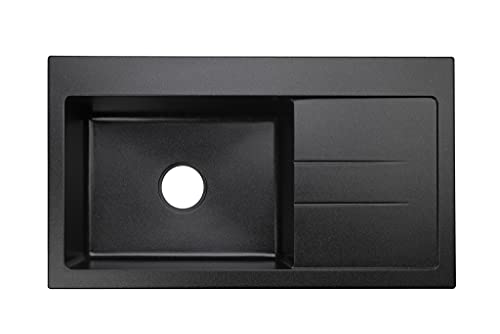
A drainboard is a small kitchen extension that finishes off the base of a sink and provides an effortless way to clean up. With this feature, you can prep food without jumping near the sink. Stainless steel is usually what they are made from. They’re functional and practical for most people as well as eco-friendly.
Fireclay Sink
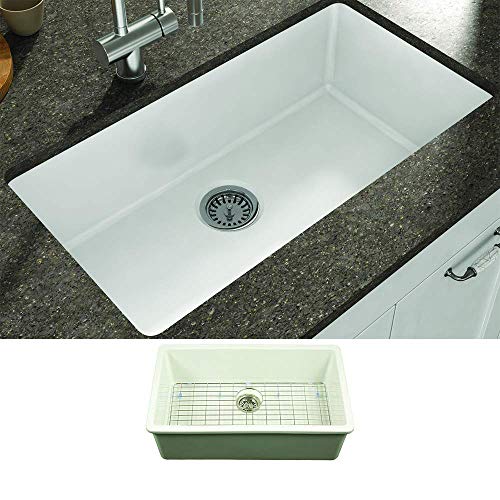
Fireclay kitchen sinks are created from a mixture of clay and glaze fused at very high temperatures, approximately 1600 Fahrenheit. They’re nearly identical to cast iron cooking pots but tend to be more durable. They won’t scratch nor stain and you can use abrasive cleaners. Fireclay sinks are usually more expensive due to the fabrication process being much more in-depth and other factors such as the work it takes for transporting the materials used to make them.
Integrated Kitchen Sink
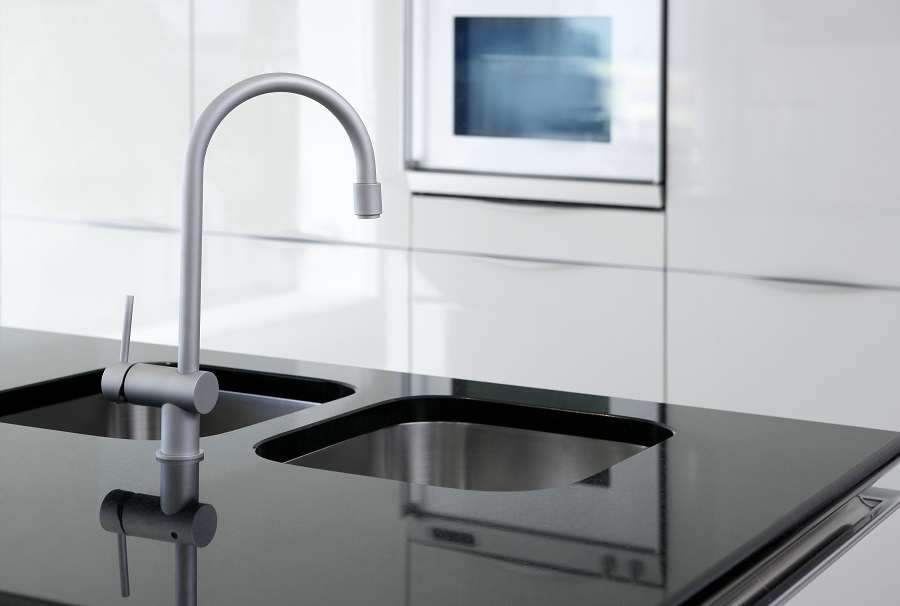
Integrated kitchen sinks are a type of countertop that is custom ordered, meaning they can be made out of any material and have a seamless look. The main advantage is eliminating the seam in an undermount sink.
Copper Sink
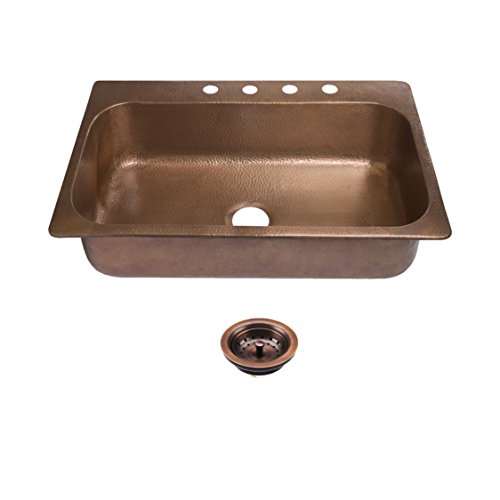
Copper kitchen sinks are largely handmade by craftsmen. This means that they can come in different sizes and have faulty drainage. Brands that provide a lifelong warranty are worth considering, as their ranges come with less risk for the purchaser. Copper sink brands may be irregularly sized or have bad suction leading to water pooling. Still, it is important to check your homework on the company’s disclaimer, which provides an easy way to pay more than return shipping costs for returning goods if need be.
Quartz Sink
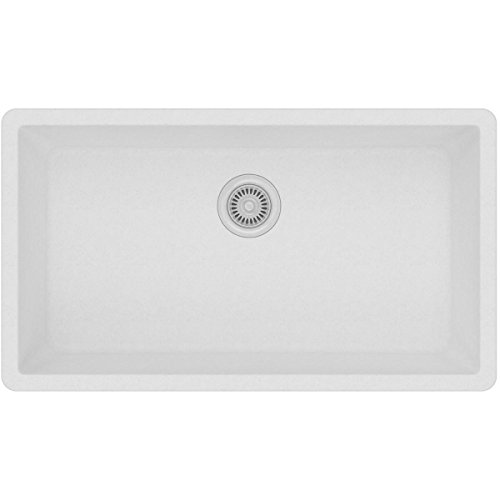
The eye-catching kitchen decor is typically the quartz material in kitchens. Most quartz surfaces are heavy and will not be compatible with cheaper countertops because of this.
Enamel Sink
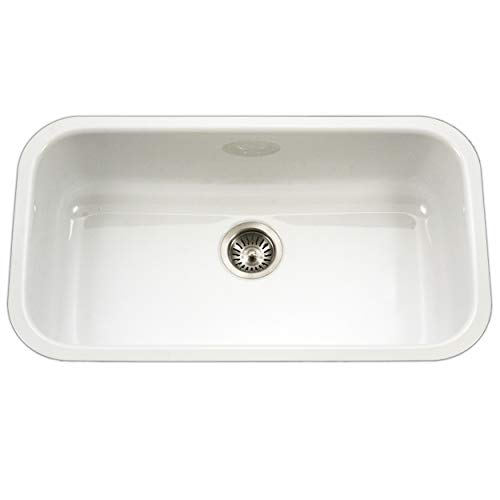
Enamel on the outside of a sink is hard and often needs to have a reinforced countertop to keep from cracking it. Sinks also stain easily and are fragile, so use only water when scrubbing surfaces and do not scratch the surface with an abrasive sponge. If damage happens, there are ways to refinish it yourself or by hiring someone professional.
Stone Composite Sink
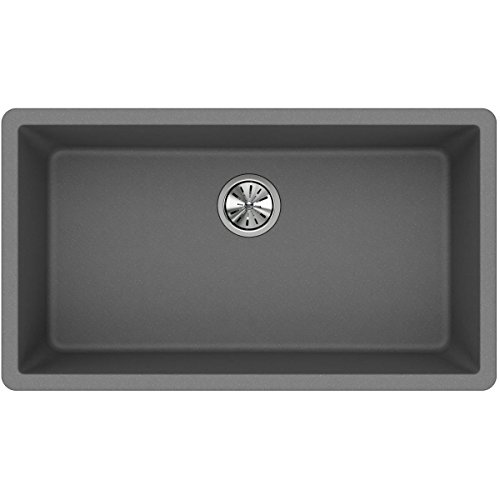
There are many different kinds of stones that people can use in their kitchen. These would include granite and marble sinks, as well as petrified wood sinks. Among these, each one is unique because of the natural variegations and pigmentation present in them. Also because they are carved from a single block, there is variation in tone and texture that has been retained which makes them really cool as a choice for kitchen sinks.
Though these are durable products, they are also porous so sealing is necessary for the prevention of scratching and staining from cleaning products. They tend to be heavy (this means they need reinforced cabinetry) so at least $1000 will need to be budgeted for installation.
Kitchen Sink Configuration
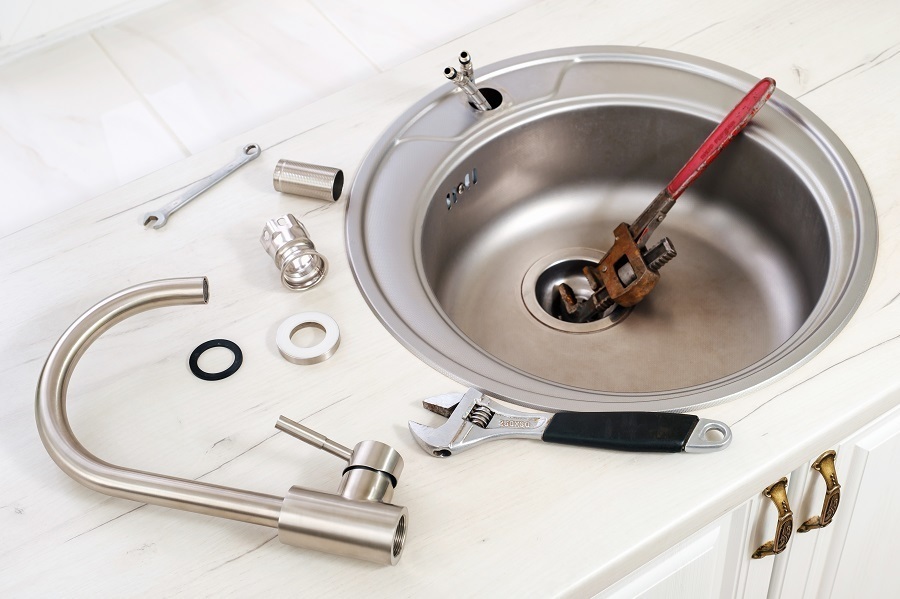
Before buying a kitchen sink, make sure you know which orientation it’s in, how many bowls are in it the size of holes needed for appliances. First, make sure that the sink is not put at an angle before buying anything else, or the cabinets can be crooked due to different pressure on both sides. Next, consider how many sinks there are and whether they will do what they need to do with your appliances.
If you are right-handed, you want to orient the kitchen so that the dishwasher is on one side of the room and the sink on another. This way, while you are washing dishes with one hand, dirty dishes can go into the dishwasher by using the other hand. If your sink has two basins, it is best if in having this be on the same side as where your dishwasher will be
There are two different kinds of sinks: traditional and modern. Traditional sinks have a rounded edge to them, whereas the modern sink has much sharper corners. A tighter radius is a new variety that falls in between these two concepts. Which, of course, you’d prefer depends on personal preference more than practicality because you can clean any type fairly easily.
For the size of your kitchen sink, you should know the width of your cabinet. This will help determine where in your kitchen to place it. The more common choices for standard kitchens are 30 inch or 36-inch width options, so finding one wide enough shouldn’t be a problem.
Another thing you have to keep in mind is whether or not you can customize your cabinet. If it cannot, this may mean that you can only use certain sizes such as 27 inch or 33-inch sinks, limiting what type of cabinet options are available to suit your needs. One way to overcome this situation will be if there is no provision for customizing these light cabinets’ size depending on their depth.
Kitchen Sink Tappings
Sinks typically have between one and four or more holes on the deck behind the bowls, these are for accessories like faucets, soap dispensers, spray hoses. The sink you should choose is able to accommodate the number of items you want.
The standard configuration for most sinks is two holes, but you can purchase a sink with three or four holes, depending on the manufacturer. If you want to hide an extra hole in the sink that’s already there you can buy both individual decorative covers and multi-hole deck plates.
Kitchen Faucets, Drainboards, and Disposals
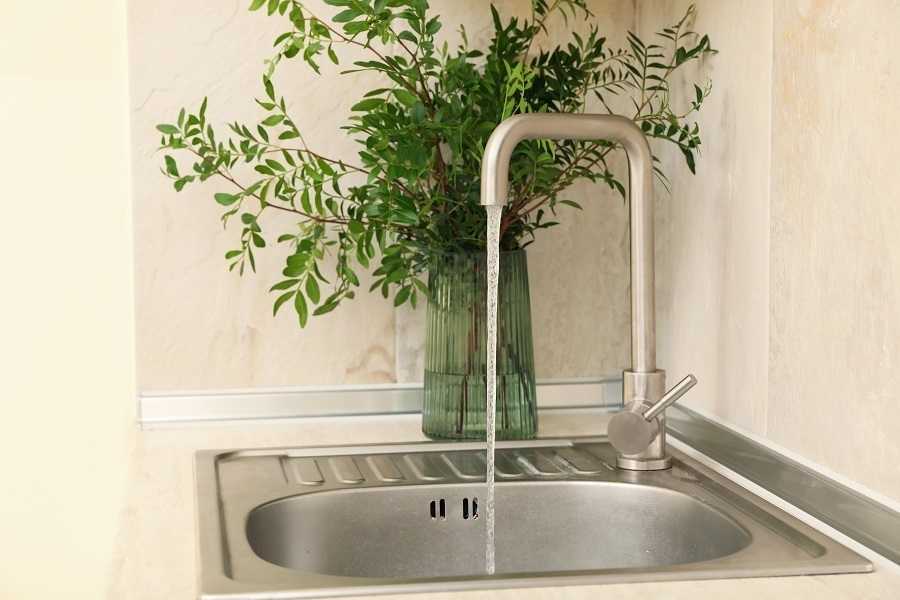
One more thing to keep in mind when choosing sink materials is how the components are arranged. It’s important to think about whether or not you want faucets, drains, and disposals before installation because it can be tricky once they’re installed.
Gaps around the drainboard can cause damage and spread bacteria. The area underneath the sink should be a dry setting for food preparation. An appropriately sized solution is to get a separate dish drying rack that stands independently on the countertop and connects directly to the oven. The use of these racks has made it easier for kitchens to keep fires from starting under their sinks.
FAQ
Stainless steel is considered the most durable material for a modern kitchen sink.
Stainless steel sinks are considered the easiest to keep clean. Even though they scratch easily, that does not prevent the ease of maintenance.
Stainless steel sinks tend to be noisier than other sink materials and they can dent, but they offer great heat and stain resistance.
Double kitchen sinks are better provided enough space. In small kitchens, single bowl sinks might be the only option.
Composite sinks are tough and highly resistant to stains and scratching, but as a general rule granite tends to hold up better than quartz.
Like stainless steel, thicker copper is less noisy and more resistant to denting.
Common problems include size variation (larger or smaller than stated specs) and improper drainage.
A heavier gauge sink can be slightly more resistant to denting and is typically less noisy.
The bright, glossy enamel finish appeals to many homeowners and can easily last for decades.
A grout line should be applied in between the sink and the countertop to create a strong bond between the two while keeping the entire body consistent and smooth in its design.




